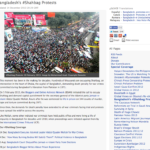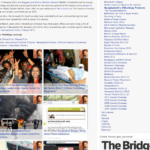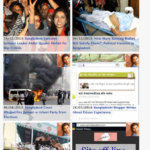[Summary: a contribution to debate about the development of open knowledge movements]

The Open Knowledge Foundation (re-named as as ‘Open Knowledge’) are soft-launching a new brand over the coming months.
Alongside the new logo, and details of how the new brand was developed, posted on the OK Wiki, appear a set of statements about the motivations, core purpose and tag-line of the organisation. In this post I want to offer an initial critical reading of this particular process and, more importantly, text.
Preliminary notes
Before going further, I want to offer a number of background points that frame the spirit in which the critique is offered.
- I have nothing but respect for the work of the leaders, staff team, volunteers and wider community of the Open Knowledge Foundation – and have been greatly inspired by the dedication I’ve seen to changing defaults and practices around how we handle data, information and knowledge. There are so many great projects, and so much political progress on openness, which OKFN as a whole can rightly take credit for.
- I recognise that there are massive challenges involved in founding, running and scaling up organisations. These challenges are magnified many times in community based and open organisations.
- Organisations with a commitment to openness, or democracy, whether the co-operative movement, open source communities like Mozilla, communities such as Creative Commons and indeed, the Open Knowledge Foundation – are generally held to much higher standards and face much more complex pressures from engaging their communities in what they do – than do closed and conventional organisations. And, as the other examples show, the path is not always an easy one. There are inevitably growing pains and challenges.
- It is generally better to raise concerns and critiques and talk about them, than leave things unsaid. A critique is about getting into the details. Details matter.
- See (1).
(Disclosure: I have previously worked as a voluntary coordinator for the open-development working group of OKF (with support from AidInfo), and have participated in many community activities. I have never carried out paid work for OKF, and have no current formal affiliation.)
The text
Here’s the three statements in the OK Branding notes that caught my attention and sparked some reflections:
About our brand and what motivates us:
A revolution in technology is happening and it’s changing everything we do. Never before has so much data been collected and analysed. Never before have so many people had the ability to freely, easily and quickly share information across the globe. Governments and corporations are using this data to create knowledge about our world, and make decisions about our future. But who should control this data and the ability to find insights and make decisions? The many, or the few? This is a choice that we get to make. The future is up for grabs. Do we want to live in a world where access to knowledge is “closed”, and the power and understanding it brings is controlled by the few? Or, do we choose a world where knowledge is “open” and we are all empowered to make informed choices about our future? We believe that knowledge should be open, and that everyone – from citizens to scientists, from enterprises to entrepreneurs, – should have access to the information they need to understand and shape the world around them.Our core purpose:
- A world where knowledge creates power for the many, not the few.
- A world where data frees us – to make informed choices about how we live, what we buy and who gets our vote.
- A world where information and insights are accessible – and apparent – to everyone.
- This is the world we choose.
Our tagline:
See how data can change the world
The critique
My concerns are not about the new logo or name. I understand (all too well) the way that having ‘Foundation’ in a non-profits name can mean different things in different contexts (not least people expecting you to have an endowment and funds to distribute), and so the move to Open Knowledge as a name has a good rationale. Rather, I wanted to raise four concerns:
(1) Process and representativeness

The message introducing the new brand to OKF-Discuss notes that “The network has been involved in the brand development process especially in the early stages as we explored what open knowledge meant to us all” referring primarily to the Community Survey run at the end of 2013 and written up here and here. However, the later parts of developing the brand appear to have been outsourced to a commercial brand consultancy consulting with a limited set of staff and stakeholders, and what is now presented appears to be being offered as given, rather than for consultation. The result has been a narrow focus on the ‘data’ aspects of OKF.
Looking back over the feedback from the 2013 survey, that data-centricity fails to represent the breadth of interests in the OKF community (particularly when looking beyond the quantitative survey questions which had an in-built bias towards data in the original survey design). Qualitative responses to the Survey talk of addressing specific global challenges, holding governments accountable, seeking diversity, and going beyond open data to develop broader critiques around intellectual property regimes. Yet none of this surfaces in the motivation statement, or visibly in the core purpose.
OKF has not yet grappled in full with idea of internal democracy and governance – yet as a network made up of many working groups, local chapters and more, for a ‘core purpose’ statement to emerge without wider consultation seem problematic. There is a big missed opportunity here for deeper discussion about ideas and ideals, and for the conceptualisation of a much richer vision of open knowledge. The result is, I think, a core purpose statement that fails to represent the diversity of the community OKF has been able to bring together, and that may threaten it’s ability to bring together those communities in shared space in future.
Process points aside however (see growing pains point above), there are three more substantive issues to be raised.
(2) Data and tech-centricity
The Open Knowledge movement I’ve met at OKFestival and other events, and that is evident through the pages of the working groups is one committed to many forms of openness – education, hardware, sustainability, economics, political processes and development amongst others. It is a community that has been discussing diversity and building a global movement. Data may be an element of varying importance across the working groups and interest areas of OKF. And technology may be an enabler of action for each. But a lot are not fundamentally about data, or even technology, as their core focus. As we found when we explored how different members of the Open Development working group understood the concept of open development in 2012, many members focussed more upon open processes than on data and tech. Yet, for all this diversity of focus – the new OK tagline emphasises data alone.
I work on issues of open data everyday. I think it’s an important area. But it’s not the only element of open knowledge that should matter in the broad movement.
Whilst the Open Knowledge Foundation has rarely articulated the kinds of broad political critique of intellectual property regimes that might be found in prior Access to Knowledge movements, developing a concrete motivation and purpose statement gave the OKF chance to deepen it’s vision rather than narrow it. The risk Jo Bates has written about, of intellectual of the ‘open’ movement being co-opted into dominant narratives of neoliberalism, appears to be a very real one. In the motivation statement above, government and big corporates are cast as the problem, and technology and data in the hands of ‘citizens’, ‘scientists’, ‘entrepreneurs’ and (perhaps contradictorily) ‘enterprises’, as the solution. Alternative approaches to improving processes of government and governance through opening more spaces for participation is off the table here, as are any specific normative goals for opening knowledge. Data-centricity displaces all of these.
Now – it might be argued that although the motivation statement takes data as a starting point – is is really at its core about the balance of power: asking who should control data, information and knowledge. Yet – the analysis appears to entirely conflate the terms ‘data’, ‘information’ and ‘knowledge’ – which clouds this substantially.
(3) Data, Information and Knowledge
The DIKW pyramid offers a useful way of thinking about the relationship between Data, Information, Knowledge (and Wisdom). This has sometimes been described as a hierarchy from ‘know nothing’ (data is symbols and signs encoding things about the world, but useless without interpretation), ‘know what’, ‘know how’ and ‘know why’.
Data is not the same as information, nor the same as knowledge. Converting data into information requires the addition of context. Converting information into knowledge requires skill and experience, obtained through practice and dialogue.
Data and information can be treated as artefacts/thigns. I can e-mail you some data or some information. But knowledge involves a process – sharing it involves more than just sending a file.
OKF has historically worked very much on the transition from data to information, and information to knowledge, through providing training, tools and capacity building, yet this is not captured at all in the core purpose. Knowledge, not data, has the potential to free, bringing greater autonomy. And it is arguably proprietary control of data and information that is at the basis of the power of the few, not any superior access to knowledge that they possess. And if we recognise that turning data into information and into knowledge involves contextualisation and subjectivity, then ‘information and insights’ cannot be by simultaneously ‘apparent’ to everyone, if this is taken to represent some consensus on ‘truths’, rather than recognising that insights are generated, and contested, through processes of dialogue.
It feels like there is a strong implicit positivism within the current core purpose: which stands to raise particular problems for broadening the diversity of Open Knowledge beyond a few countries and communities.
(4) Power, individualism and collective action
I’ve already touched upon issues of power. Addressing “global challenges like justice, climate changes, cultural matters” (from survey responses) will not come from empowering individuals alone – but will have to involve new forms of co-ordination and collective action. Yet power in the ‘core purpose’ statement appears to be primarily conceptualised in terms of individual “informed choices about how we live, what we buy and who gets our vote”, suggesting change is purely the result of aggregating ‘choice’, yet failing to explore how knowledge needs to be used to also challenge the frameworks in which choices are presented to us.
The ideas that ‘everyone’ can be empowered, and that when “knowledge is ‘open’ […] we are all empowered to make informed choices about our future” fails to take account of the wider constraints to action and choice that many around the world face, and that some of the global struggles that motivate many to pursue greater openness are not always win-win situations. Those other constraints and wider contexts might not be directly within the power of an open knowledge movement to address, or the core preserve of open knowledge, but they need to be recognised and taken into account in the theories of change developed.
In summary
I’ve tried to deal with the Motivation, Core Purpose and Tag-line statements with as carefully as limited free time allows – but inevitably there is much more to dig into – and there will be other ways of reading these statements. More optimistic readings are possible – and I certainly hope might turn out to be more realistic – but in the interest of dialogue I hope that a critical reading is a more useful contribution to the debate, and I would re-iterate my preliminary notes 1 – 5 above.
To recap the critique:
- Developing a brand and statement of core purpose is an opportunity for dialogue and discussion, yet right now this opportunity appears to have be mostly missed;
- The motivation, core purpose and tagline are more tech-centric and data-centric than the OKF community, risking sidelining other aspects of the open knowledge community;
- There need to be a recognition of the distinction of data, information and knowledge, to develop a coherent theory of change and purpose;
- There appears to be an implicit libertarian individualism in current theories of change, and it is not clear that this is compatible with working to address the shared global challenges that have brought many people into the open knowledge community.
Updates:
There is some discussion of these issues taking place on the OKFN-Discuss list, and the Wiki page has been updated from that I was initially writing about, to re-frame what was termed ‘core purpose’ as ‘brand core purpose’.









